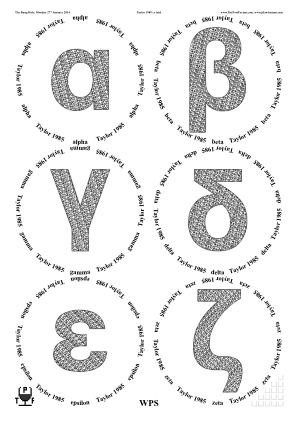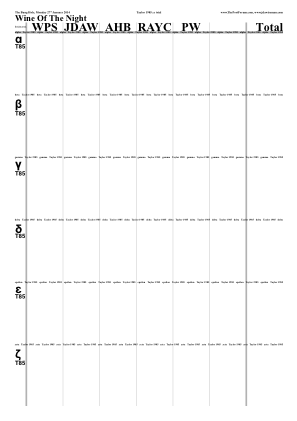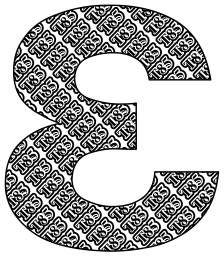Page 1 of 3
Taylor 1985 case testing 27th of January 2014
Posted: 14:13 Wed 15 Jan 2014
by WS1
Taylor 1985 seem to slowly but surely leaving the "closed phase" it was in for quite a long period of time. Hence it found its way on our watch list.

In oder to prepare for future purchases we want to test the bt variation on a case which was stored perfectly. Aside we want to test as well sensibly various open/decanting techniques at the same time.
As a date we have the week starting 27th of January in mind but are also open for alternative dates. Since the organisation (sourcing of the Taylor 1985 case) comes down mostly to me I suggest the 27th of January as a date to start with. The venue is the Bunghole or as it is called now Davy's Bar and Grill on High Holborn.
After the scene is set now the potential cost implications. In short the attendees of the tasting share the cost of opening 6bts or more of Taylor 85. This is expected to be 40£-50£s.
regards
WS1
attendees:
JDAW (from 19:00 onwards)
RAYC
WS1
AHB
PHILW
Reserves:
Chris Doty
Re: Taylor 1985 case testing 27th of January 2014
Posted: 18:39 Wed 15 Jan 2014
by jdaw1
Current draft of
the placemats.


A detail:

Those looking at
the PDF might notice that WPS, JDAW, and DRT all have stars on their TN sheets (and in different arrangements). That could be you too if you request it.

(WPS, /
Sideways)

(JDAW,
/Alternating)

(DRT,
/Upright) Update: DRT not coming.
Permission being sought. Permission obtained ✠“☺. But I won’t arrive for the evening session until about 19:00.
WS1 wrote:pop and pour
WS1 wrote:decanting straight before the tasting
Please, what’s the difference between these two?
Re: Taylor 1985 case testing 27th of January 2014
Posted: 18:47 Wed 15 Jan 2014
by RAYC
jdaw1 wrote:
WS1 wrote:pop and pour
WS1 wrote:decanting straight before the tasting
Please, what’s the difference between these two?
To me, "pop and pour" means what it says on the tin - taking the cork out and pouring straight to glass.
"decant straight before tasting" means actually pouring it out into a decanter (thereby introducing a lot more air to the port prior to it getting into glass)
Wolfgang may have had something different in mind though.
Re: Taylor 1985 case testing 27th of January 2014
Posted: 18:52 Wed 15 Jan 2014
by DRT
Yes please.
Re: Taylor 1985 case testing 27th of January 2014
Posted: 19:15 Wed 15 Jan 2014
by jdaw1
RAYC wrote:To me, "pop and pour" means what it says on the tin - taking the cork out and pouring straight to glass.
"decant straight before tasting" means actually pouring it out into a decanter (thereby introducing a lot more air to the port prior to it getting into glass)
For sediment-free wines, I agree. But one must de-sediment port before consumption.
As you say, Wolfgang to pronounce.
Re: Taylor 1985 case testing 27th of January 2014
Posted: 19:22 Wed 15 Jan 2014
by DRT
We are likely to drink lots of T85 in the next few years. Should we use this opportunity to identify the optimum decanting time?
Perhaps 2, 4, 6 and 8 hours would give us the answer?
Re: Taylor 1985 case testing 27th of January 2014
Posted: 22:17 Wed 15 Jan 2014
by jdaw1
jdaw1 wrote:Permission being sought.
Permission granted, but I won’t arrive until about 19:00.
Re: Taylor 1985 case testing 27th of January 2014
Posted: 22:40 Wed 15 Jan 2014
by WS1
jdaw1 wrote:RAYC wrote:To me, "pop and pour" means what it says on the tin - taking the cork out and pouring straight to glass.
"decant straight before tasting" means actually pouring it out into a decanter (thereby introducing a lot more air to the port prior to it getting into glass)
For sediment-free wines, I agree. But one must de-sediment port before consumption.
As you say, Wolfgang to pronounce.
Both of you are right, but my initial idea was really the emergency pop and pour that can happen at home when you are thirsty and just go to the cellar and take a bt of port and open it. The sediment is less of an issue since bt did not travel a lot or was moved a lot. Or in my case I have always potential candidates standing up as I know other members of

have too. To accomodate this 6bts will stand up at our venue from tomorrow evening onwards in their cool cellar.
regards
WS1
Re: Taylor 1985 case testing 27th of January 2014
Posted: 22:45 Wed 15 Jan 2014
by WS1
DRT wrote:We are likely to drink lots of T85 in the next few years. Should we use this opportunity to identify the optimum decanting time?
Perhaps 2, 4, 6 and 8 hours would give us the answer?
good point; RAYC and I may try a bt tomorrow when picking up 18bts from the desired stash and make an initial assessment. Happy to go with your suggestion and try different decanting times especially if we are enough people. For sure we have enough Taylor 1985 for this experiment.


regards
WS1
Re: Taylor 1985 case testing 27th of January 2014
Posted: 23:40 Wed 15 Jan 2014
by jdaw1
Placemat draft above.
Re: Taylor 1985 case testing 27th of January 2014
Posted: 23:55 Wed 15 Jan 2014
by RAYC
There are quite a few variables here - are we at risk of trying to test too many things?
There's an experiment to be done in tasting through a case - using the same decant method for all bottles in order to get an idea of the typical spread of bottle variation after 26 odd years in the same case. To my knowledge, we have not done this (though a few of us got some idea at the "
Real Men Drink Port" book launch a couple of years ago).
There's also an experiment to be done in decant methods, as WS1 has proposed.
The question I have in relation to WS1's proposal is how we will be able to assess whether a certain decant method is better than another without first having an appreciation of how much bottle variation we should expect naturally from a single case...?
Perhaps if we go down that route first we should ensure at least 2 bts opened for any one decant method (to provide a measure of insurance against a single below-average bottle swaying results).
In terms of a bottle preparation / decant method comparison, sending two bottles in the post via parcelfoce 24 in the week before the tasting would also be an interesting experiment.
Re: Taylor 1985 case testing 27th of January 2014
Posted: 00:01 Thu 16 Jan 2014
by jdaw1
RAYC wrote:Perhaps if we go down that route first we should ensure at least 2 bts opened for any one decant method (to provide a measure of insurance against a single below-average bottle swaying results).
Six bottles has become twelve.
RAYC wrote:In terms of a bottle preparation / decant method comparison, sending two bottles in the post via parcelfoce 24 in the week before the tasting would also be an interesting experiment.
Twelve bottles has become fourteen.
There are currently four people in this tasting. Hence Rob’s plan is excellent.

Re: Taylor 1985 case testing 27th of January 2014
Posted: 00:15 Thu 16 Jan 2014
by jdaw1
I have booked the Function Room in
The Bung Hole (57 High Holborn, London WC1V 6DT, tel +44 20 7831 8365,
streetmap.co.uk,
maps.google.co.uk).
Later they will need to know how many people and glasses.
Re: Taylor 1985 case testing 27th of January 2014
Posted: 00:19 Thu 16 Jan 2014
by djewesbury
I'd like to attend but it's strictly provisional at this point. I'm in Edinburgh that morning and could change my flight to divert home via a stop in London; but it is contingent on more than one factor.
Re: Taylor 1985 case testing 27th of January 2014
Posted: 11:02 Thu 16 Jan 2014
by PhilW
RAYC wrote:The question I have in relation to WS1's proposal is how we will be able to assess whether a certain decant method is better than another without first having an appreciation of how much bottle variation we should expect naturally from a single case...?
Perhaps if we go down that route first we should ensure at least 2 bts opened for any one decant method (to provide a measure of insurance against a single below-average bottle swaying results).
This was my first thought also; however I don't think two would be sufficient: if they differ, which one is representative? I would suggest three, so that in the event of a difference in one, the other two are taken as representative. However, this is probably impracticable to do for all tests, and the assumption of minimal variation is probably reasonable, though could be worthwhile to test separately, e.g. by 3-4 bottles (rather than the full case) all opened with the same method to assess variation.
In terms of variations, there are many things we could add, such as including a bottle shaken immediately prior to decant, or subject to significant temperature variation; probably better to focus on the decant method/timing to keep things manageable.
Depending on numbers attending and hence bottles, using WS and DRTs suggestions, I'd go for:
- Auduze method
- 0hr no decant == pop and pour
- 0hr double decanted == straight before the tasting
- 4-6hr double decanting == (late) lunchtime - x3 to also provide variance control
- 8-10hr double decanting == in the morning
- 20-24hr double decanting == the night before
Would we additionally want any variations on the timing of the Auduze (e.g. Auduze 4hr vs Auduze 8hr)?
I have a very slim chance to attend, but would have to confirm closer to the date; best to assume I will not be available for now.
Re: Taylor 1985 case testing 27th of January 2014
Posted: 11:12 Thu 16 Jan 2014
by jdaw1
PhilW wrote:- Auduze method
- 0hr no decant == pop and pour
- 0hr double decanted == straight before the tasting
- 4-6hr double decanting == (late) lunchtime - x3 to also provide variance control
- 8-10hr double decanting == in the morning
- 20-24hr double decanting == the night before
The ‟variance control” depends on the type of variance. Does a case have a range of bottles, averaging a bell-shaped distribution? Or is it more of a binary distribution: five out of six are goodies (with their own small distribution around ‘good’); and one out of six is a duffer (that covering a very wide distribution)? If the former, then three bottles for only one method might hint at the width of the distribution. But if the distribution is more good-versus-duffer binary, then it wouldn’t much help.
Re: Taylor 1985 case testing 27th of January 2014
Posted: 11:44 Thu 16 Jan 2014
by PhilW
jdaw1 wrote:PhilW wrote:- Auduze method
- 0hr no decant == pop and pour
- 0hr double decanted == straight before the tasting
- 4-6hr double decanting == (late) lunchtime - x3 to also provide variance control
- 8-10hr double decanting == in the morning
- 20-24hr double decanting == the night before
The ‟variance control” depends on the type of variance. Does a case have a range of bottles, averaging a bell-shaped distribution? Or is it more of a binary distribution: five out of six are goodies (with their own small distribution around ‘good’); and one out of six is a duffer (that covering a very wide distribution)? If the former, then three bottles for only one method might hint at the width of the distribution. But if the distribution is more good-versus-duffer binary, then it wouldn’t much help.
Agreed. The hope would be that with a case of well-stored 85s there would only be one duffer, if any, and that this could be further managed by pre-selection of the 8 bottles from the case of twelve with best fill levels and no apparent signs of seepage. If our assumption is then that we would expect little detectable bottle variation, then the three control bottles would only provide a basic test of that; If no notable difference, the rest of our test is (probably) valid and it increases our confidence in the comparison of the differently decanted bottles; If any significant difference noted between the control bottles then results of comparing decant methods would become tentative at best. Extending to two of each, and noting that there was (ideally) no difference between the members of each pair would be even better.
Re: Taylor 1985 case testing 27th of January 2014
Posted: 14:46 Thu 16 Jan 2014
by WS1
Hi,
with regards to the posts about the suggested sampling I agree to all. The limitations given due to number of interested attendees suggest though we should not open more than only 6 -8 bts of Taylor 1985 since I can see this otherwise ending in a Taylor 1985 orgy

Furthermore knowing that in order to get to statistical evidence we would need probably to open 30+ bts I feel it is better to go back to the initial idea opening bts of a stash and see how we like them. Even with different decanting methods applied we should see based on this sample if it is a good stash or not.
regards
WS1
Re: Taylor 1985 case testing 27th of January 2014
Posted: 14:56 Thu 16 Jan 2014
by DRT
The debate about which particular scientific experiment we are going to conduct is extremely interesting. The experiment I intend conducting is to determine whether or not I enjoy drinking T85 from a number of different bottles simultaneously. I think I already know the outcome, but am willing to make the sacrifice required to confirm it.
Re: Taylor 1985 case testing 27th of January 2014
Posted: 16:02 Thu 16 Jan 2014
by djewesbury
DRT wrote:The debate about which particular scientific experiment we are going to conduct is extremely interesting. The experiment I intend conducting is to determine whether or not I enjoy drinking T85 from a number of different bottles simultaneously. I think I already know the outcome, but am willing to make the sacrifice required to confirm it.
Well said that man. Part of good science is deciding how to delimit your field!
Re: Taylor 1985 case testing 27th of January 2014
Posted: 16:09 Thu 16 Jan 2014
by Miguel Simoes
Love how you're approaching this.
If a move to London ever pops up on the radar I will be much happier to consider it than before, knowing there is a bunch of guys out there that approach Port the way you do!
Re: Taylor 1985 case testing 27th of January 2014
Posted: 19:54 Thu 16 Jan 2014
by Alex Bridgeman
I'm hoping to be able to attend and should be able to confirm later this week.
If I can attend, I would love to be able to taste a bottle which has been double decanted against one which has been decanted normally.
Actually, ideally I would like to try one bottle, half of which has been double decanted into a half bottle and the other half has been decanted into a half bottle decanter - then I can taste the same wine and see if there is a noticeable difference in the way the same wines tastes.
I'd be happy to provide the half bottle and the half bottle decanter if anyone supported this bit of the experiment.
Re: Taylor 1985 case testing 27th of January 2014
Posted: 19:57 Thu 16 Jan 2014
by djewesbury
AHB wrote:I'm hoping to be able to attend and should be able to confirm later this week.
If I can attend, I would love to be able to taste a bottle which has been double decanted against one which has been decanted normally.
Actually, ideally I would like to try one bottle, half of which has been double decanted into a half bottle and the other half has been decanted into a half bottle decanter - then I can taste the same wine and see if there is a noticeable difference in the way the same wines tastes.
I'd be happy to provide the half bottle and the half bottle decanter if anyone supported this bit of the experiment.
Actually, very sensible. Cuts out the three bottle conundrum.
Re: Taylor 1985 case testing 27th of January 2014
Posted: 20:50 Thu 16 Jan 2014
by Alex Bridgeman
I can confirm my attendance.
Re: Taylor 1985 case testing 27th of January 2014
Posted: 21:02 Thu 16 Jan 2014
by jdaw1
As others have commented, we can’t do everything. So we start at the beginning. In order to design experiments, we need to know more about the within-case variability. So my proposal is that all bottles are treated identically, all being decanted at 13:00. We then drink (and doubtless enjoy) multiple bottles of T85, seeking some measure of the within-case variability.
Later we can design subsequent experiments using that established fact (Starz W. et al, Journal of Port Consumption, 2014).




 (WPS, /
(WPS, / (JDAW,
(JDAW,  (DRT,
(DRT,